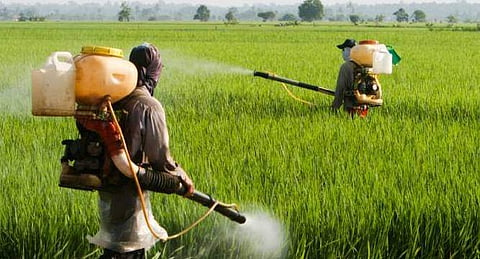

HYDERABAD: There is a pressing need for regulation on usage of chemical fertilizers in farms and effective handling of sewage in Telangana, as ground water in the State is getting polluted with toxic amounts of nitrate. As per a report by Telangana Ground Water Department accessed by Express, half of the State’s ground water wells from where samples were tested by the department, contain nitrate levels higher than the maximum permissible limit by Bureau of Indian Standards (BIS) for drinking water.
The department tested 3,051 groundwater samples from across the State, of which 1,525 samples were found to have contained nitrate exceeding the maximum permissible limit. Moreover, while BIS permits a maximum of 100mg/L (milligram per litre) content of nitrate and desirable amount is 45mg/L, in some ground water wells, the levels exceed even beyond 800-1,000 mg/L.
Testing of ground water samples was done in the pre-monsoon and post-monsoon periods of the year 2017. In post-monsoon period due to rains and good availability of surface water which seeps into the ground, the nitrate levels in ground water is expected to get diluted.
Monsoon scenarios
The percentage of groundwater samples with nitrate level above the BIS standards vary from district to district. Barring Asifabad and Warangal Urban, all other 29 districts of the State had more than 30 per cent ground water samples contaminated with nitrate levels above BIS standards, during the pre-monsoon season. In as many as ten districts, more than 60 per cent of the ground water samples were found to be contaminated with nitrate levels above BIS standard, the highest being in Gadwal district (78 per cent samples).
The post-monsoon scenario was no better with 43 per cent groundwater samples were found to be containing nitrate levels higher than the BIS standard against the 50 per cent in pre-monsoon. The per cent of samples polluted with nitrate in Gadwal, actually increased in the post-monsoon to 88 per cent, indicating higher usage of fertilizers in farming after the rains. Telangana Ground Water Department Director Dr Pandith Madhnure, said: “The reasons behind high nitrate levels in ground water are anthropogenic. High usage of chemical fertilizers and improper management of sewage are the two major reasons.”
Poor sewage management
A direct correlation can be seen between usage of chemical fertilizers and the high nitrate levels in groundwater. Consider this, as per the data presented in Telangana Statistical Year Book-2017, Kothagudem, Nalgondam Suryapet and Khammam utilize the highest amount of Nitrogen-based fertilizers. Not surprisingly, these are among the top five districts along with Gadwal, having high number of groundwater samples contaminated with nitrate levels beyond BIS levels.
The sad state of affairs of sewage handling in Telangana was recently exposed by Express, as it was reported that only Greater Hyderabad has operational Sewage Treatment Plants in the State, which treat just about half of the around 1,450MLD of sewage generated daily in the city.
One can correlate this to the fact 78 per cent of ground water samples in the city were found to be containing high levels of nitrate, beyond the BIS standards, even in the post-monsoon period. The highest nitrate value was recorded at 259mg/L in the city, in a ground water sample collected form Asifnagar.
Impact on health
While the government is working on providing piped drinking water through Mission Bhagiratha, ground water is still a drinking water source for at least 13.4 per cent of rural households and 2.4 per cent urban households in the State. Moreover, ground water is an important source of potable water in long-term, as it contains large reserves.
Consumption of ground water polluted with nitrate is dangerous. As per a WHO report, nitrate gets reduced to its chemical form of nitrite that can cause Methaemoglobinaemia, wherein enough amounts of oxygen are not supplied to the body, which can cause asphyxia. The consumption of water with high amounts of nitrate also increases the risk of cancer.